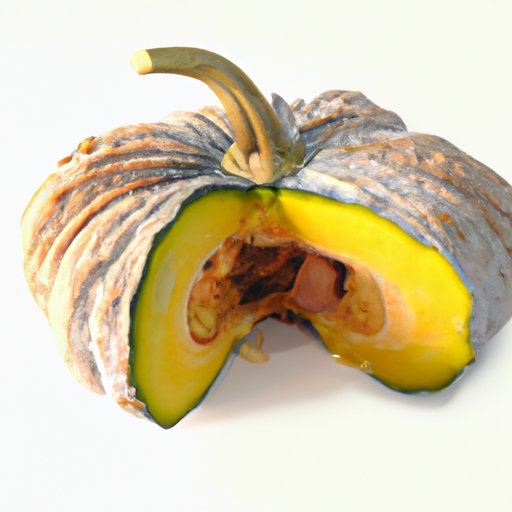
I. Introduction
Pumpkins are a beloved fall staple that seem to take over the grocery stores and pumpkin patches around the country each year. While pumpkin pie or roasted pumpkin seeds may be the first things that come to mind when you think of pumpkin, some may be wondering whether you can eat pumpkin raw. In this article, we’ll explore the benefits and risks of consuming raw pumpkin and provide tips for safely incorporating it into your diet.
II. The Benefits and Risks of Eating Raw Pumpkin: Get the Facts
Raw pumpkin is packed with vitamins and minerals that provide a range of health benefits. The bright orange color of a pumpkin implies a high concentration of beta-carotene, an antioxidant that converts into vitamin A in the body. Additionally, raw pumpkin is an excellent source of vitamin C and potassium.
However, there are some potential risks to eating raw pumpkin. One risk is digestive issues, such as bloating, gas, or diarrhea due to the high fiber content. Additionally, consuming raw pumpkin may increase the risk of bacterial contamination, particularly if the pumpkin has been sitting out for an extended period of time or hasn’t been washed properly.
III. How to Safely Incorporate Raw Pumpkin into Your Diet
If you’re interested in trying raw pumpkin, it’s important to take some basic safety measures. Start by thoroughly washing the pumpkin under running water and scrubbing it with a vegetable brush if needed. If you plan to consume the pumpkin raw, be sure to peel it first or cut it into small pieces with a clean knife. Avoid eating pumpkin that looks damaged or has mold on it.
If you’re concerned about the risks associated with raw pumpkin, you can also consider cooking or roasting it. Cooking the pumpkin can help break down some of the tougher fibers and improve your body’s ability to absorb the nutrients. To cook pumpkin, you can steam it, roast it in the oven, or stir-fry it with other vegetables.
IV. Raw Pumpkin Recipes for a Delicious and Nutritious Meal
If you’re ready to try incorporating raw pumpkin into your diet, here are a few ideas for healthy and delicious recipes:
Raw Pumpkin Pie Smoothie:
Blend 1 cup of cubed raw pumpkin, 1 peeled banana, 1/2 cup of unsweetened almond milk, 1/2 teaspoon of pumpkin pie spice, and 1/4 teaspoon of vanilla extract. Enjoy your pumpkin pie fix in a refreshing smoothie!
Spicy Roasted Pumpkin Salad:
Toss cubed pumpkin with olive oil, salt, pepper, and paprika. Roast in the oven until soft and slightly caramelized. Serve over mixed greens with sliced avocado, cherry tomatoes, and crumbled feta cheese.
Raw Pumpkin Energy Bites:
In a food processor, pulse 1 cup of raw pumpkin seeds, 1/2 cup of rolled oats, 1/2 cup of pitted dates, 1/4 cup of almond butter, and 1/4 teaspoon of cinnamon until well combined. Roll into bite-sized balls and refrigerate until firm.
V. From Sweet to Savory: Raw Pumpkin Goes Beyond Just Pie
Pumpkin pie may be the most popular way to enjoy pumpkin, but raw pumpkin can be used in a wide variety of dishes. You can add it to salads, stir-fries, smoothies, or even use it as a substitute for pasta or rice.
For a unique twist, try making pumpkin hummus by blending cooked pumpkin with chickpeas, tahini, garlic, and lemon juice. Or, try using raw pumpkin as a base for a dairy-free pumpkin cheese sauce by blending it with nutritional yeast, garlic powder, and a pinch of salt.
VI. Raw Pumpkin: A Nutritional Powerhouse?
Raw pumpkin is loaded with nutrients that are essential for overall health. In addition to the vitamins mentioned earlier, pumpkin also contains fiber, which can help regulate digestion, and antioxidants that may help reduce inflammation and prevent chronic disease.
However, the nutritional content of raw pumpkin can vary depending on the type of pumpkin and how it was grown. For example, some pumpkins may have higher levels of beta-carotene than others. Additionally, cooking pumpkin can make certain nutrients, such as vitamin A and beta-carotene, more bioavailable.
VII. The Versatility of Raw Pumpkin: How to Use it in Smoothies, Salads, and More
One of the best things about using raw pumpkin is its versatility in the kitchen. You can use it in a variety of dishes, from sweet to savory, and experiment with different flavors and textures.
You can add raw pumpkin to smoothies as a way to boost your daily intake of nutrients. Try blending it with banana, almond milk, and a pinch of cinnamon for a tasty fall-inspired smoothie. For salads, try shaving raw pumpkin with a vegetable peeler and tossing it with mixed greens, pecans, and dried cranberries.
VIII. Raw Pumpkin vs. Cooked Pumpkin: Which One is Better for Your Health?
Both raw and cooked pumpkin have their own unique benefits for health. Raw pumpkin may be higher in some nutrients, such as vitamin C and potassium, because cooking can reduce the levels of water-soluble vitamins. However, cooking can make other nutrients, such as beta-carotene and vitamin A, more bioavailable to the body.
The best way to get the maximum nutritional benefits of pumpkin is to eat it in a variety of ways, both raw and cooked. By doing so, you can ensure that you’re getting a wide range of vitamins, minerals, and antioxidants.
IX. Conclusion
Beyond its traditional use as a pie filling, pumpkin can be a nutritious addition to your daily diet, whether eaten raw or cooked. By following some basic safety measures and experimenting with different recipes and cooking methods, you can enjoy the many benefits of this versatile ingredient.





